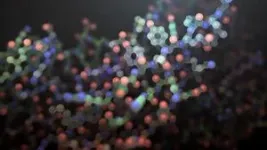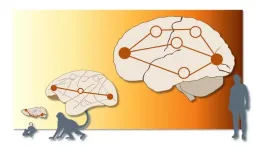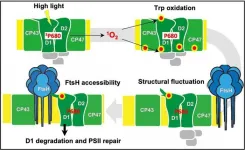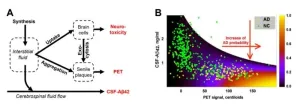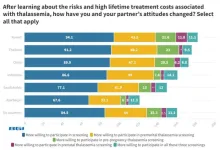(Press-News.org) Research pioneer Dr. Daniel Drucker has much to be proud of, as the GLP-1-based diabetes drugs hailing from his early research are named 2023 breakthrough of the year by the Science Magazine.
Not only have millions of people with type 2 diabetes benefitted from GLP-1 agonists, but the drugs also produced wide-ranging health benefits beyond weight loss in two recent patient trials.
For years, GLP-1 agonists have been known to have a fortuitous side effect of improving metabolic health, but how this is regulated in the body remains unclear. Now Dr. Drucker, who has dedicated his life’s work to understanding how these drugs work, has a new paper that begins to unravel the mystery with a novel finding – it all starts in the brain.
His team at the Lunenfeld-Tanenbaum Research Institute, part of Sinai Health, have discovered a gut-brain-immune network that controls inflammation across the body affecting organ health, in a project led by postdoctoral scientist Chi Kin Wong.
The research, published in the journal Cell Metabolism holds promise for understanding and treating metabolic diseases.
Known as GLP-1 receptor agonists, for glucagon like peptide 1, these medications mimic the gut hormone GLP1, which regulates blood sugar levels and appetite. Among them are the popular weight loss jabs Ozempic/Wegovy and Mounjaro/Zepbound, but similar compounds have been used for more than 18 years to treat type 2 diabetes.
"One of the really interesting things about the GLP-1 drugs is that beyond the control of blood sugar and body weight they also seem to reduce the complications of chronic metabolic disease.” said Dr. Drucker, who holds the BBDC-Novo Nordisk Chair in Incretin Biology and is Professor of Medicine at the Temerty Faculty of Medicine, University of Toronto.
Research has found that some drugs in these group may lower the risk of heart disease, such as heart failure, stroke, fatty liver disease and kidney disease.
“We know from clinical studies that GLP-1 does all this amazing stuff in people, but we don't fully know how they work”, said Dr. Drucker.
It’s why these drugs are in the limelight.
“For all their promise, GLP-1 agonists have raised more questions than they have answered – a hallmark of a true breakthrough,” wrote Holden Thorp, Science journals’ editor-in-chief, in an Editorial in the latest issue of Science.
Dr. Drucker’s early work on the GLP-1 hormone provided an understanding of how it works at the molecular level and paved the way for multiple diabetes drugs, Ozempic among them. For his work, he has received some of the most prestigious awards, including the 2021 Canada Gairdner International Award, a top accolade in life sciences, the 2023 Wolf Prize in Medicine and the Order of Canada, among others.
Now, Dr. Drucker focused on teasing out how GLP-1 drugs reduce inflammation, which is a common factor in chronic metabolic diseases. Inflammation is the process by which the immune system recognizes and removes foreign agents such as viruses and bacteria and promotes healing. In chronic form, however, it can persist without an external cause and lead to organ damage.
Given that immune cells are embedded within most organs, an obvious assumption was that the drugs dampen inflammation by interacting with GLP-1 receptors on the immune cells. This is the case in the gut, where large numbers of immune cells are activated by GLP-1. But in other organs, the number of immune cells containing GLP-1 receptors is negligible, indicating another mechanism to be at play.
“The strange thing is that you can’t find many GLP-1 receptors in all these other organs where GLP-1 seems to work,” said Dr. Drucker.
Dr. Drucker had a hint that the brain might be involved for two reasons: the GLP-1 receptors are abundant in the brain, and the brain and the immune system communicate with all organs in the body.
For the study, Wong induced systemic inflammation in mice by either injecting them with a bacterial cell wall component or a bacterial slur to induce sepsis, an extensive inflammation throughout the body that leads to organ damage. Remarkably, GLP-1 agonists reduced inflammation, but only when its receptors in the brain were left unblocked. When these brain receptors were pharmacologically inhibited or genetically removed in mice, the drugs’ ability to reduce inflammation was lost.
The findings demonstrated for the first time that there is a GLP-1-brain-immune axis that controls inflammation across the body independent of weight loss, even in peripheral organs devoid of GLP1 receptors, said Dr. Drucker.
Dr. Anne-Claude Gingras, Director of the LTRI and Vice-President of Research at Sinai Health, emphasized the study's impact: “As the scientific community deservingly celebrates GLP-1 agonists and their impact, there are many unknowns left. Dr. Drucker and his team have remained tenacious in their efforts to unpack how these drugs work, and this study deepens our understanding of metabolism and the complex brain-immune network that regulates it.”
The work is far from complete, however. The team is now trying to pinpoint the brain cells that interact with GLP-1. They are also looking at various mouse models of inflammation, including heart disease, atherosclerosis, and liver and kidney inflammation, to establish whether the beneficial effects of GLP-1 in each case are indeed mediated through the brain.
Dr. Drucker said that understanding how GLP-1 dampens inflammation may open new avenues for reducing the complications associated with type 2 diabetes and obesity.
He added that the recognition of GLP-1 biology as the Science Magazine 2023 breakthrough of the year “highlights the expanding clinical impact of GLP-1, and the tremendous potential for basic scientific discovery to continuously improve human health.”
END
Toronto study identifies new concepts for GLP-1 action in the brain, the 2023 Science magazine breakthrough of the year
For years GLP-1 agonists have been known to be beneficial for metabolic health beyond weight loss but how this is regulated remains unclear. The study begins to unpack how these drugs reduce inflammation in the organs.
2023-12-18
ELSE PRESS RELEASES FROM THIS DATE:
Coral atoll islands may outpace sea-level rise with local ecological restoration, scientists say
2023-12-18
Ecological restoration may save coral atoll islands from the rising seas of climate change, according to an international team of scientists, conservationists, and an indigenous leader.
While global carbon emission reduction is imperative, local measures could be the key to the islands outpacing sea levels, they argue today in the journal Trends in Ecology & Evolution.
“Far from being doomed, in their natural state most coral atoll islands could adapt to sea level rise”, says Dr Sebastian Steibl from the University of Auckland ...
NIH researchers create genetic atlas detailing early stages of zebrafish development
2023-12-18
Researchers at the National Institutes of Health have published an atlas of zebrafish development, detailing the gene expression programs that are activated within nearly every cell type during the first five days of development, a period in which embryos mature from a single cell into distinct cell types. These diverse cells become tissues and organs that form juvenile fish capable of swimming and looking for food. The findings are published in Developmental Cell.
“Perhaps surprisingly, tiny zebrafish provide us with significant insight ...
Unleashing canine travel: Hospitality and tourism sector urged to adapt to dog-friendly travel demands
2023-12-18
Estimated to be worth USD 50.1 billion by 2030, a Surrey team of researchers has uncovered the potential of the growing dog-friendly travel market. The Covid-19 pandemic drove an increase in UK household dog ownership, creating a need for tourism providers to adapt to accommodate these four-legged family members.
The Surrey team set out to understand why people travel with their dogs, how they feel about it, and what challenges they face doing so.
Lori Hoy, PhD Researcher and lead author of the study at the University of Surrey, said:
"Some reports suggest that the UK dog population stands at 11 million, with 29% of UK adults having a dog in their ...
More parallel ‘traffic' observed in human brains than in animals
2023-12-18
In a study comparing human brain communication networks with those of macaques and mice, EPFL researchers found that only the human brains transmitted information via multiple parallel pathways, yielding new insights into mammalian evolution.
When describing brain communication networks, EPFL senior postdoctoral researcher Alessandra Griffa likes to use travel metaphors. Brain signals are sent from a source to a target, establishing a polysynaptic pathway that intersects multiple brain regions “like a road with many stops along the way.”
She explains that structural brain ...
The role of oxidized tryptophan residues in repairing damaged photosystem II protein
2023-12-18
Photosynthesis refers to the fundamental biological process of the conversion of light energy into chemical energy by chlorophyll (a green pigment) containing plants. This seemingly routine process in plants sustains all the biological life and activities on Earth. First reaction of photosynthesis occurs at a site called photosystem II (PSII), present on the thylakoid membrane in the chloroplast where light energy is transferred to chlorophyll molecules. PSII is made up of a complex group of proteins, including the D1 and D2 reaction center proteins.
Light ...
Breaking the mold: Zarbio and Georgia State scientists unveil game-changing theory on Alzheimer's disease
2023-12-18
Despite affecting millions worldwide, Alzheimer's disease (AD) has long lacked effective treatments due to a fundamental inadequacy of our understanding of its etiology and pathogenesis. The absence of an integrative theory connecting the molecular origins of AD with disturbances at the organelle and cell levels, changes in relevant biomarkers, and population-level prevalence has hindered progress. Even though most scientists only hope that an integrative theory of AD will emerge soon, scientists from Zarbio and Georgia State University discovered sufficient data to formulate a framework for such a theory.
The molecular and cellular ...
Scientists collect aardvark poop to understand how the species is impacted by climate in Africa
2023-12-18
CORVALLIS, Ore. – In a first-of-its-kind study of aardvarks, Oregon State University researchers spent months in sub-Saharan Africa collecting poop from the animal and concluded that aridification of the landscape is isolating them, which they say could have implications for their long-term survival.
“Everyone had heard of aardvarks and they are considered very ecologically important but there has been little study of them,” said Clint Epps, a wildlife biologist at Oregon State. “We wanted to see if we could collect enough data to begin to understand them.”
In ...
Thalassemia screening in Thailand: Medical Sciences Dean advocates for elevated trust
2023-12-18
- Insights from Professor Sakorn Pornprasert, Dean, Faculty of Associated Medical Sciences at Chiang Mai University, on raising thalassemia awareness in Thailand.
Thalassemia, a genetic disorder affecting hemoglobin production, poses a significant public health challenge in Thailand, with a high prevalence and substantial healthcare costs. According to Thailand's Ministry of Public Health, approximately 18-24 million or 30-40 percent of the Thai population carries the thalassemia gene.
Professor Sakorn Pornprasert, Dean, Faculty of Associated Medical Sciences, Chiang Mai University, shared his views on BGI Genomics Global 2023 State of Thalassemia Awareness ...
Lung nodule program provides benefits patients ineligible for lung cancer screening
2023-12-18
(Denver—December 18, 2023) – Adopting a lung nodule program (LNP) may increase the detection of early lung cancer for patients who are not eligible for lung cancer screening under existing age eligibility criteria, according to a study published in the Journal of Thoracic Oncology, an official journal of the International Association for the Study of Lung Cancer.
LNPs are established to follow up on lung nodules that are frequently identified during routine imaging for reasons other than suspected lung cancer or lung cancer screening.
The research was conducted by a team led by Dr. Raymond U. Osarogiagbon, MBBS, FACP, chief scientist ...
Multi-site study reveals addressable socioeconomic barriers to prenatal diagnosis of congenital heart defects
2023-12-18
Prenatal diagnosis of congenital heart defects – the most common birth defects in the United States – is associated with improved outcomes. Despite its importance, however, overall prevalence of prenatal diagnosis is low (12-50 percent). A recent multi-center study surveyed caretakers of infants who received congenital heart surgery in the Chicago area and found that social determinants or influencers of health constitute significant barriers to prenatal diagnosis from the patients’ perspective.
In ...
LAST 30 PRESS RELEASES:
Disinfecting drinking water produces potentially toxic byproducts — new AI model is helping to identify them
Unplanned cesarean deliveries linked to higher risk of acute psychological stress after childbirth
Healthy aging 2026: fresh pork in plant-forward diets supported strength and brain-health biomarkers in older adults
Scientists identify pre-cancerous states in seemingly normal aging tissues
Itaconate modifications: mechanisms and applications
Potential tumor-suppressing gene identified in pancreatic cancer
Winners of the 2026 Hill Prizes announced
Autonomous AI agents developed to detect early signs of cognitive decline
Study finds ocean impacts nearly double economic cost of climate change
Increased deciduous tree dominance reduces wildfire carbon losses in boreal forests
Researchers discover how a respiratory bacterium obtains essential lipids from the human body and targets fat-rich tissues
Locust swarms destroy crops. Scientists found a way to stop that
More resources and collaboration needed to support prevention and treatment of obesity
Two types of underconfidence linked to anxiety and gender
Insects are victims too: Global study shows impacts of invasive alien species on populations
Pioneering natural, degradable polymer capsules
Forestry is becoming digital and automated
Maternity baby deaths much higher in northern England than in the South
Mosquitoes’ thirst for human blood has increased as biodiversity loss worsens
The stop-smoking medication varenicline may also work for cannabis use disorder
Potential new treatment for sepsis
Study reveals how many hours of video games per week might be too many
Electrospinning for mimicking bioelectric microenvironment in tissue regeneration
Home fingertip oxygen monitors less accurate for people with darker skin tones
Six weeks in a cast no less effective than surgery for unstable ankle fractures
Precautionary approach to alcohol-free and low alcohol drinks needed to protect public health, say experts
Gas-atomized Ca–Mg alloy powders produce hydrogen simply by adding water — high-efficiency hydrogen generation at room temperature
British redcoat’s lost memoir reveals harsh realities of life as a disabled veteran
World-leading rare earth magnet recycling facility launches in UK
Corday Selden selected for the Oceanography Society Early Career Award
[Press-News.org] Toronto study identifies new concepts for GLP-1 action in the brain, the 2023 Science magazine breakthrough of the yearFor years GLP-1 agonists have been known to be beneficial for metabolic health beyond weight loss but how this is regulated remains unclear. The study begins to unpack how these drugs reduce inflammation in the organs.

